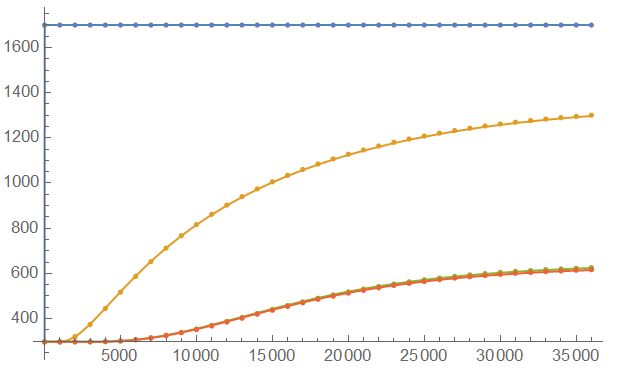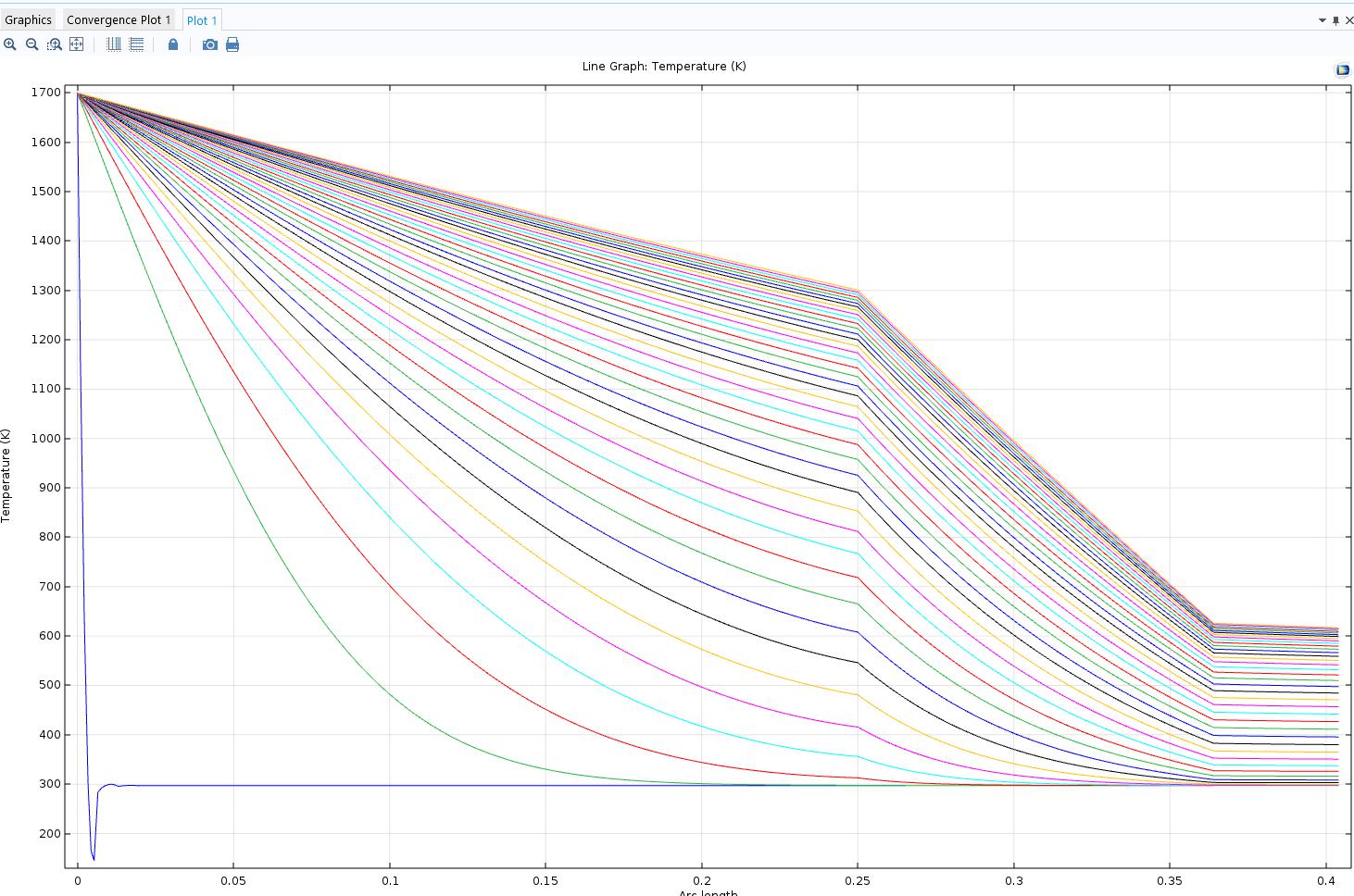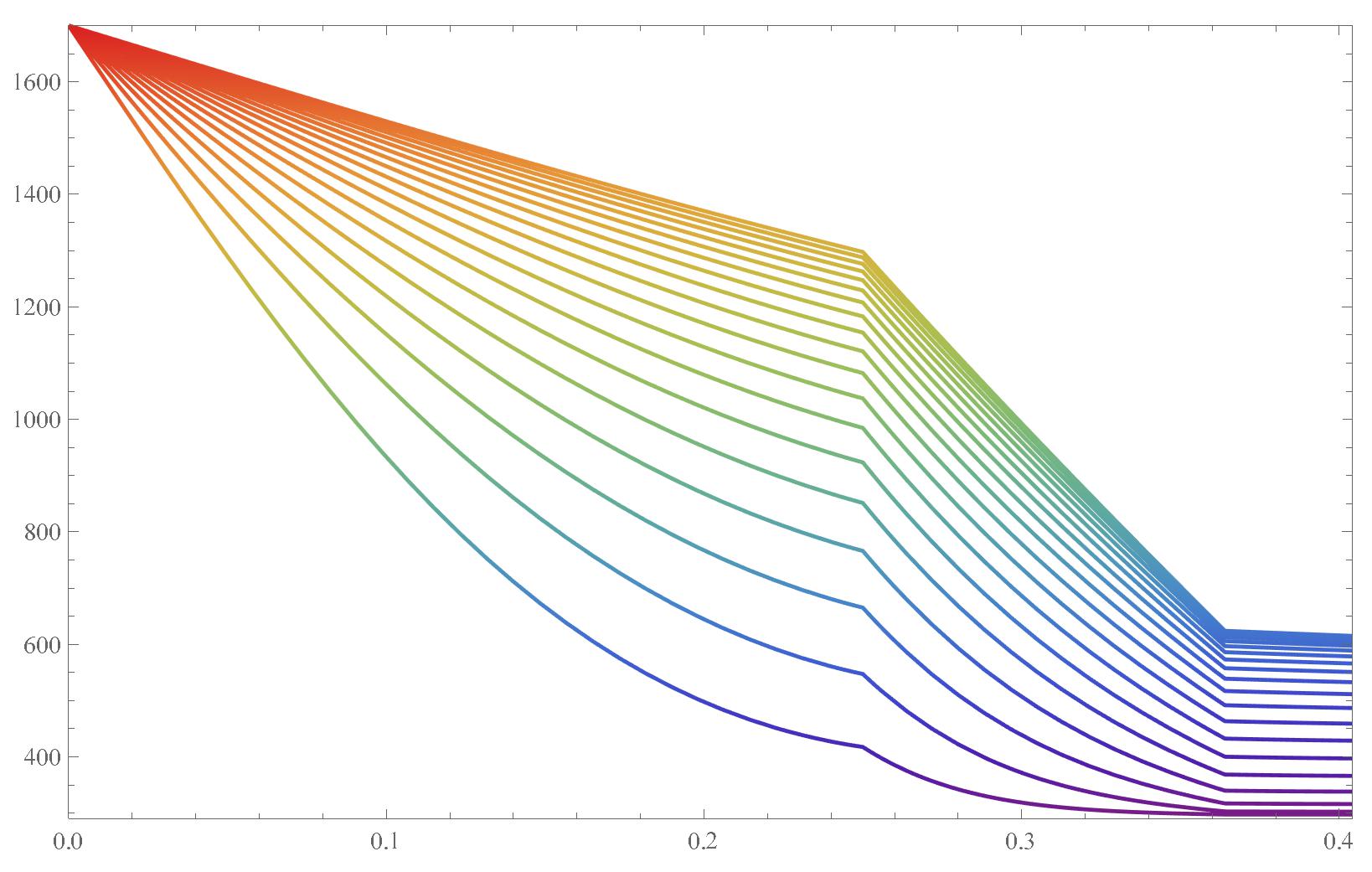I have not checked @Alex Trounev's answer, but this answer shows that there is good agreement between Mathematica and COMSOL Multiphysics.
Since you have a variety of thicknesses, I create a little routine so that I could mesh each region with the same number of elements (100 each).
Needs["NDSolve`FEM`"]
(* User Supplied Parameters *)
g = {0.25, 0.114, 0.04};(*thickness*)
gw = {0}~Join~Accumulate[g];
λ = {8, 1.8, 44};
ρ = {3100, 2100, 7800};
cp = {1050, 1100, 540};
(* Create a Multiregion Mesh *)
ClearAll[seg, appendCrdRight]
seg[thick_, nelm_, marker_] := Module[{crd, inc, marks},
crd = Subdivide[0, thick, nelm];
inc = Partition[Range[crd // Length], 2, 1];
marks = ConstantArray[marker, inc // Length];
<|"c" -> crd, "i" -> inc, "m" -> marks|>
]
appendCrdRight[a1_, a2_] := Module[{crd, inc, marks, len, lcrd},
len = a1["c"] // Length;
lcrd = a1["c"] // Last;
inc = Join[a1["i"], a2["i"] + len - 1];
crd = Join[a1["c"], Rest[a2["c"] + lcrd]];
marks = Join[a1["m"], a2["m"]];
<|"c" -> crd, "i" -> inc, "m" -> marks|>]
a = Fold[appendCrdRight, MapIndexed[seg[#1, 100, First[#2]] &, g]];
mesh = ToElementMesh["Coordinates" -> Partition[a["c"], 1],
"MeshElements" -> {LineElement[a["i"], a["m"]]},
"BoundaryElements" -> {PointElement[{{1}, {a["c"] // Length}}, {1,
2}]}];
Show[mesh["Wireframe"["MeshElementStyle" -> {Red, Green, Blue}]],
PlotRange -> {-0.01, 0.01}]

Now, we can set up the PDE system and solve it on our newly created mesh.
σ = First[UnitConvert[Quantity["StefanBoltzmannConstant"]]];
Trob = 1700;
Tamb = 297;
h = 10;
ε = 0.85;
rhocp = Evaluate[
Piecewise[{{ρ[[1]] cp[[1]], gw[[1]] <= x <= gw[[2]]},
{ρ[[2]] cp[[2]], gw[[2]] <= x <= gw[[3]]},
{ρ[[3]] cp[[3]], gw[[3]] <= x <= gw[[4]]}}]];
k = Evaluate[Piecewise[{{λ[[1]], gw[[1]] <= x <= gw[[2]]},
{λ[[2]], gw[[2]] <= x <= gw[[3]]},
{λ[[3]], gw[[3]] <= x <= gw[[4]]}}]];
bc1 = DirichletCondition[T[t, x] == Trob, x == 0];
bc2conv = NeumannValue[h*(Tamb - T[t, x]), x == Last@gw];
bc2rad = NeumannValue[ε*σ*(Tamb^4 - T[t, x]^4),
x == Last@gw];
ic1 = T[0, x] == Tamb;
op = Inactive[Div][{{-k}}.Inactive[Grad][T[t, x], {x}], {x}] +
rhocp*Derivative[1, 0][T][t, x];
pde = op == bc2conv + bc2rad;
sol = NDSolveValue[{pde, bc1, ic1},
T, {t, 0, 36000}, {x} ∈ mesh, StartingStepSize -> 0.01];
The model I set up in COMSOL Multiphysics (v 5.5) shows similar results to those shown in the OP.

For comparison purposes, I extracted the temperature data at each phase boundary point in COMSOL.

I exported these data to compare versus the Mathematica solution.
data = {{0, 1000, 2000, 3000, 4000, 5000, 6000, 7000, 8000, 9000,
10000, 11000, 12000, 13000, 14000, 15000, 16000, 17000, 18000,
19000, 20000, 21000, 22000, 23000, 24000, 25000, 26000, 27000,
28000, 29000, 30000, 31000, 32000, 33000, 34000, 35000,
36000}, {1700, 1700, 1700, 1700, 1700, 1700, 1700, 1700, 1700,
1700, 1700, 1700, 1700, 1700, 1700, 1700, 1700, 1700, 1700, 1700,
1700, 1700, 1700, 1700, 1700, 1700, 1700, 1700, 1700, 1700, 1700,
1700, 1700, 1700, 1700, 1700, 1700}, {297, 297.9169787`,
320.0562147`, 374.4552427`, 444.9013611`, 517.6131837`,
587.4876631`, 652.6604327`, 712.3644688`, 766.9603206`,
816.5391802`, 861.866491`, 902.8730203`, 940.4564489`,
974.5556695`, 1005.867455`, 1034.417079`, 1060.665637`,
1084.866141`, 1107.411419`, 1128.099762`, 1146.931167`,
1164.637928`, 1180.832645`, 1195.499525`, 1208.917884`,
1221.536363`, 1233.003818`, 1243.320249`, 1252.972747`,
1261.872597`, 1269.909554`, 1277.155111`, 1284.007597`,
1290.216067`, 1295.780522`, 1300.901468`}, {297, 297.0000101`,
297.0108185`, 297.2403045`, 298.3422144`, 301.3296677`,
306.8304462`, 315.0786727`, 326.0187665`, 339.0198185`,
353.9950315`, 370.1369655`, 387.5159699`, 405.1722292`,
423.1836315`, 440.8382141`, 458.14222`, 474.6735528`,
490.3439464`, 504.9171794`, 518.5145476`, 531.1360512`,
542.7808248`, 553.4493263`, 563.1415743`, 571.9455027`,
580.0023514`, 587.2015743`, 593.5431713`, 599.3724133`,
604.6264161`, 609.2270331`, 613.2390417`, 617.0233547`,
620.3526001`, 623.2267777`, 625.8287217`}, {297, 297.0000065`,
297.0084849`, 297.2058139`, 298.1991325`, 300.9831864`,
306.2034638`, 314.1201414`, 324.7019404`, 337.3400768`,
351.9481631`, 367.722907`, 384.7337123`, 402.0228897`,
419.6676093`, 436.9560503`, 453.8952359`, 470.0643493`,
485.3780489`, 499.6031165`, 512.8593059`, 525.1466173`,
536.4765686`, 546.8430665`, 556.2458626`, 564.7760878`,
572.5801167`, 579.5433842`, 585.6658902`, 591.2927421`,
596.3610853`, 600.7928104`, 604.6517643`, 608.293677`,
611.4944415`, 614.2540579`, 616.7511966`}};
Show[Plot[Evaluate[sol[t, #] & /@ gw], {t, 0, 36000}],
ListPlot[data[[2 ;; -1]], DataRange -> {0, 36000}]]

As you can see, there is very little difference between COMSOL (dots) and Mathematica (solid lines).
Update to Include the Basic Form
@AlexTrounev requested a comparison of the basic form to COMSOL as defined by:
$$\rho {{\hat C}_p}\frac{{\partial T}}{{\partial t}} - \lambda \frac{{{\partial ^2}T}}{{\partial {x^2}}} = 0$$
To use the FEM method, I recommend to cast your equations into coefficient form as shown FEM Tutorial.
$$\frac{{{\partial ^2}}}{{\partial {t^2}}}u + d\frac{\partial }{{\partial t}}u + \nabla \cdot\left( { - c\nabla u - \alpha u + \gamma } \right) + \beta \cdot\nabla u + au - f = 0$$
I find it easier to make comparisons of commercial solver (such as COMSOL) results to Mathematica results.
As shown with the following workflow, the Alex's basic form also matches COMSOL quite closely. I also included a case where I tried to thermal diffusivity in coefficient form and it fails to match COMSOL. Finally, it may be interesting to note that COMSOL's Laplace Equation Interface does not contain a Laplacian, rather:
$$\nabla \cdot \left( { - \nabla u} \right) = 0$$
(* User Supplied Parameters *)
g = {0.25, 0.114, 0.04};(*thickness*)
gw = {0}~Join~Accumulate[g];
λ = {8, 1.8, 44};
ρ = {3100, 2100, 7800};
cp = {1050, 1100, 540};
σ = First[UnitConvert[Quantity["StefanBoltzmannConstant"]]];
Trob = 1700;
Tamb = 297;
h = 10;
ε = 0.85;
bmesh = ToBoundaryMesh["Coordinates" -> Partition[gw, 1],
"BoundaryElements" -> {PointElement[{{1}, {2}, {3}, {4}}]}]; nrEle \
= 100; pt = Partition[gw, 2, 1]; mesh =
ToElementMesh[bmesh,
"RegionMarker" ->
Transpose[{Partition[(Mean /@ pt), 1], {1, 2, 3},
Abs[Subtract @@@ pt]/nrEle}]]
Show[mesh["Wireframe"["MeshElementStyle" -> {Red, Green, Blue}]],
PlotRange -> {-0.01, 0.01}]
rhocp = Evaluate[
Piecewise[{{ρ[[1]] cp[[1]], gw[[1]] <= x <= gw[[2]]},
{ρ[[2]] cp[[2]], gw[[2]] <= x <= gw[[3]]},
{ρ[[3]] cp[[3]], gw[[3]] <= x <= gw[[4]]}}]];
k = Evaluate[Piecewise[{{λ[[1]], gw[[1]] <= x <= gw[[2]]},
{λ[[2]], gw[[2]] <= x <= gw[[3]]},
{λ[[3]], gw[[3]] <= x <= gw[[4]]}}]];
bc1 = DirichletCondition[T[t, x] == Trob, x == 0];
bc2conv = NeumannValue[h*(Tamb - T[t, x]), x == Last@gw];
bc2rad = NeumannValue[ε*σ*(Tamb^4 - T[t, x]^4),
x == Last@gw];
ic1 = T[0, x] == Tamb;
(* Coefficient Form *)
op = Inactive[Div][{{-k}}.Inactive[Grad][T[t, x], {x}], {x}] +
rhocp*Derivative[1, 0][T][t, x];
pde = op == bc2conv + bc2rad;
Tcoef = NDSolveValue[{pde, bc1, ic1},
T, {t, 0, 36000}, {x} ∈ mesh, StartingStepSize -> 0.01];
(* Alex's "Basic Form" *)
op = rhocp*D[T[t, x], t] - k D[T[t, x], x, x];
pde = op == bc2conv + bc2rad;
Tbasic = NDSolveValue[{pde, bc1, ic1},
T, {t, 0, 36000}, {x} ∈ mesh, StartingStepSize -> 0.01];
(* Coefficient form with thermal diffusivity *)
bc2conv = NeumannValue[h*(Tamb - T[t, x])/rhocp, x == Last@gw];
bc2rad = NeumannValue[ε*σ*(Tamb^4 - T[t, x]^4)/
rhocp, x == Last@gw];
op = Inactive[Div][{{-k/rhocp}}.Inactive[Grad][T[t, x], {x}], {x}] +
Derivative[1, 0][T][t, x];
pde = op == bc2conv + bc2rad;
Talphainside =
NDSolveValue[{pde, bc1, ic1}, T, {t, 0, 36000}, {x} ∈ mesh,
StartingStepSize -> 0.01];
(* Plot Alex's "Basic Form" *)
Show[Plot[Evaluate[Tbasic[t, #] & /@ gw], {t, 0, 36000}],
ListPlot[data[[2 ;; -1]], DataRange -> {0, 36000}]]
(* Comparison of Methods *)
Show[Plot[Evaluate[Tcoef[t, #] & /@ gw], {t, 0, 36000},
PlotStyle -> ConstantArray[{Opacity[0.2], Thickness[0.015]}, 4]],
Plot[Evaluate[Talphainside[t, #] & /@ gw], {t, 0, 36000},
PlotStyle -> Dashed],
Plot[Evaluate[Tbasic[t, #] & /@ gw], {t, 0, 36000},
PlotStyle -> DotDashed]]












{t, 0, 100}I do obtain a solution, which can be plotted e.g. usingPlot3D[sol[t, x], {t, 0, 100}, {x, 0, gw[[3]]}, PlotRange -> All]and looks reasonable. You may have to wait a looong time to get the full range you want. I also do get a weirdParterror, but I am not sure where that comes from. What do you see? $\endgroup$bc2radlooks like the contribution of thermal radiation, if so, probably it should not be aNeumannValue, but an inhomogeneous term of heat conduction equation. You'd better show us the system in traditional math notation so we can help checking. 2. The continuity of heat flux is lost in your code, check these posts for more info: mathematica.stackexchange.com/q/131542/1871 mathematica.stackexchange.com/a/121739/1871 $\endgroup$bc2convandbc2rad. In the heat transfer section of the PDEModels overview you can also find some heat transfer verification tests. $\endgroup$